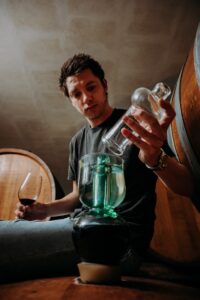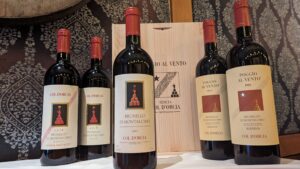The young boy, Santiago, could not contain his excitement as his father drove down a dirt road 35 miles long as there was no more favorite place on Earth than their final destination. As they got closer and closer, the little child waved to the men riding horses, who wore traditional straw hats to combat the sun, and he squealed with delight when he saw their old adobe colonial wine cellar in the distance. The second the car stopped, Santiago ran out of it to go out into the vineyards where multi-generational families were working their land and he immediately placed his hands in the soil – the healthy, vibrant soil, and rubbed it all over his face. He wanted to be part of the vineyards that radiated life as he followed the families around, asking them every question that popped into his inquisitive head. One of the fathers smiled to himself as this was very common for Santiago; he was not like his other siblings. As Santiago was the middle child who knew from the moment he could think that he wanted to be part of the long heritage of making wine, no shiny toy could entice him away from the grape vines that fascinated him to no end.
It was an idyllic place to grow up, the tiny village of Caliboro in the Maule Valley, Central Chile. Chile is already an extremely isolated place as it is very long and narrow, with the Andes Mountains, the most extended continental mountain range in the world, on one side and the Pacific Ocean on the other. Still, Caliboro is a little Chile within Chile as it is isolated with a range of Mountains blocking one section of the tiny village and a river, one of the few in Chile without a bridge, on another side, with only a long dirt road to connect it to the outside world. And so, Caliboro is a pure place where the ancient peasant ways are kept as the people live in harmony with their surroundings and there is an endless cycle of the soil giving to the people and the people giving back to the soil – keeping it healthy and alive.
One would think that Santiago was one of the kids of the multi-generational farmers who worked with their parents from an early age, as he had a singular focus on the vineyards and the cellars. But his parents were from Italy; his father was from their own multi-generational family of a large wine company from the Piedmont region. One day, his father moved the family to a remote area in Chile when Santiago was barely a year old.
A New Adventure
Santiago’s father, Count Francesco Marone Cinzano, comes from a long line of nobility in Northern Italy; his family started making sparkling wine and vermouth in the 1700s, and their family brand, Cinzano, is well-known worldwide. But in the ’90s, the Cinzano family sold the company and that is when Francesco decided to take his family, with a one-year-old Santiago, to Chile.
Other places in Chile have gained more recognition as world-famous producers have built elaborate wineries that are awe-inspiring in other wine regions. Still, Francesco had already come from having all the complications with a large global company and he craved an area tucked away from the limelight where he could focus on making good wine from a special piece of property. Something that would be uniquely his own and, hopefully, could pass it down to one of his kids. He found Caliboro in Maule as he saw that it had enough rainfall, drought is an issue in Chile, it is slightly cooler than its more famous northern neighboring wine regions and there is a swing in temperatures from day to night that helps to achieve ripeness without losing acidity. So, he imported grape vines from France as he noticed one big thing these farmers needed was high-quality genetic material.
As Francesco observed the local farmers tending their vineyards, he could not help but notice that they were not only abiding by organic practices but they were following biodynamic farming. These farmers had yet to read a book on biodynamics as they were following what their father and grandfather had been teaching them, as Maule Valley was one of the first areas in Chile to be planted with vines. Compared to many modern farming practices, what these Chilean farmers were doing seemed primitive. Yet, Francesco noticed how healthy and disease-resistant the vines were, and his wines, Erasmo, had beautiful balance and an overall lovely quality.
Col d’Orcia
Francesco wasn’t the only one in his family who craved a different type of life as his father, Santiago’s grandfather, bought a centuries-old historic Tuscan wine estate in 1973. The estate is named Col d’Orcia, and it is one of the consortium’s founding members, the Consorzio Brunello di Montalcino, started in 1967. It has been bottling the much-admired wines of Brunello di Montalcino since the end of the 1800s under a different name and before the wine was even labeled Brunello di Montalcino. Santiago’s grandfather completely fell in love with the area of Montalcino within the region of Tuscany as it seemed like everything someone desired grew there without any issues: olive trees, various grains, truffles and incredible Sangiovese grape vines.
In 2005, Santiago’s father was called back to Italy to take over the Col d’Orcia estate and so he took the family back to Italy but this time to Tuscany. Until then, the estate had been managed with that commercially-minded structure that had been rooted in the Cinzano family for generations. But Santiago’s father was used to another mindset that was about focusing on each plot of the vineyards, so he converted all the vineyards to organic farming, officially becoming certified in 2010, as well as incorporated biodynamic practices such as placing manure in cow horns to assist in the symbiotic cycle of life. Not only is Col d’Orcia the third largest owner of vineyards classified as Brunello di Montalcino but it is also a working farm with various animals and preserved woodland where wild boar can roam.
Another Way To Connect
Santiago and his father are already planning for the next 20 to 30 years and they are working with Sangiovese clones that have traits that will perform well during warmer vintages, which is happening more and more often. One of the vineyards that they have selected to become a single vineyard bottling is their Nastagio Vineyard, planted with clones selected for warmer temperatures, and the clay-dominant soil can retain water and assist the vines better during hot, dry vintages. This vineyard is a working experiment that they have been researching since they took over the estate, as they feel it could be the future for what will be considered a top vineyard for the great wines of Brunello di Montalcino.
Another single vineyard bottling is their Poggio al Vento Vineyard, which Santiago’s grandfather planted almost 50 years ago. It was an odd choice during the time, as the soil is sandy, making more subtle, elegant wines instead of bigger ones that were more in demand during the 1970s. But today, Poggio al Vento is considered a jewel for its elegance and beautiful nuances.
Yet Santiago said that his father never got the chance to ask his grandfather why he planted it there all those years ago as, unfortunately, his grandfather died in a car crash in 1989. It is natural to think we have all the time in the world to ask all the questions we want to know about our parents, only to one day be looking back, after they have passed, wishing we had one more day to get to know them better as people. But as Santiago’s father walks around their estate and visits the Poggio al Vento Vineyard, there is a connection, as maybe he wasn’t the first Cinzano to have a grower’s mentality, and that he and his father, now with his own son, Santiago, share a deep love for the land and will do everything in their power to protect it.
***Link to original article on Forbes: https://www.forbes.com/sites/cathrinetodd/2023/09/15/italian-wine-producer-inspired-by-south-america-to-change-tuscan-estate-from-commercial-mindset-to-grower-mentality/
2018 Col d’Orcia, Brunello di Montalcino DOCG: 100% Sangiovese. A wine that dances gently along the palate with bright red cherry fruit and stony minerality that is vibrant and fresh with a hint of toasted spices and a good amount of flesh on the body that balances the marked acidity.
2018 Col d’Orcia, Brunello di Montalcino DOCG, Nastagio Vineyard: 100% Sangiovese from a single vineyard cru. This wine takes more time to open, but once it does, complex notes such as smoldering earth and Mediterranean herbs come out with dark, brooding fruit on the palate and ample tannins that are muscular and through time, notes such as underbrush, black licorice and wildflowers start to reveal themselves along a sustained, powerful length of flavor.
2016 Col d’Orcia, Brunello di Montalcino Riserva DOCG, Poggio al Vento Vineyard: 100% Sangiovese from a single vineyard cru. Intriguing sandalwood aroma with a deep concentration of multi-layered fruit nuanced in its delivery with finely etched tannins and lots of crisp acidity with a very long, expressive floral finish. A stunning wine.
2015 Col d’Orcia, Brunello di Montalcino Riserva DOCG, Poggio al Vento Vineyard: 100% Sangiovese from a single vineyard cru. Riper, juicer fruit with plush mid-palate and hints of baking spice with a round texture and overall generosity that is incredibly delicious.
2004 Col d’Orcia, Brunello di Montalcino Riserva DOCG, Poggio al Vento Vineyard: 100% Sangiovese from a single vineyard cru. Exciting developed notes such as tar, black truffles and crushed rose petals with silky tannins that have a touch of plush quality on the palate with still lots of juicy red and black fruit with a lovely overall texture.
1995 Col d’Orcia, Brunello di Montalcino DOCG: 100% Sangiovese. Multifaceted wine with tapenade, dried porcini mushrooms, cigar box and broken earth that is extremely soft in the mouth with an underlying note of dried rose petals and a lot of concentration of fruit on the finish, which is quite impressive at this age.













